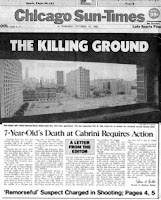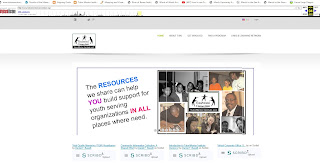On Monday I included this graphic in
an article titled "Kids not living in poverty need mentors, too."
This was in response to the most recent mass murder of 10 people in Buffalo, NY by a teen who had adopted White Supremist beliefs, was able to purchase an automatic rifle, then acted upon his beliefs.
What caused this? What might prevent it? I'm going to point to a lot of information in this article, so I hope you'll bookmark it, then refer to it often.
At the right is a graphic that I've used for more than 25 years to show the role of mentors and extra adults in "pushing" kids through school and into jobs and careers and the role of businesses, universities, hospitals, philanthropy and government in "pulling" kids through school, using mentoring as one important strategy. Providing part-time jobs and internships is another. View the graphic in
this article.
Over the past 30 years I've used maps to focus attention and resources on high poverty areas of Chicago, where tutor/mentor programs are a place where kids can connect with volunteers from many different backgrounds and help kids on their journey through school, while also opening doors to jobs and college opportunities for many.
I've come to understand this as a form of "bridging" social capital, and have been influenced by writers such as Robert D. Putnam. In
this article I point to several articles where I've written about Putnam's "
Our Kids" book and "bridging" social capital.
In all of these efforts, I've focused on expanding "who you know" for kids who's family and personal network has too few people modeling the many types of careers they might aspire to if they had a college degree, or advanced vocational training after high school.
Here are three more articles that show this strategy:Mentor Role in Larger Strategy -
click hereTransforming Adults Involved in Volunteer-Based Tutor/Mentor Programs -
click here
Understanding and Creating Bridging Social Capital -
click hereMuch of my motivation has come from seeing stories like this 1992
Chicago Sun-Times article in Chicago media, over-and-over, since the late 1970s. Too many inner city kids are losing their lives. Street killings are just the most visible sign of this. Poverty leads to more stress, more severe illnesses, poor performance in school, involvement with juvenile justice, and other things, all which reduce future opportunities.
Yet, most of the mass shootings have not been black and brown kids killing people of other races. Those have mostly been done by White kids. (
see data)
So far I've written about strategies that reach and benefit kids living in high poverty areas, who might be less prone to acts of violence against each other if they had more hope and opportunity. Providing these opportunities continues to be my focus.
However, we have a problem in America. In the graphic at the top of this article I ask "What about kids who don't live in high poverty?"
In the third extra reading articles above is a link to a paper titled "
Social Capital: The Bonds that Connect", written by Michael Woolcock. He provides clear definitions of "bridging" and "bonding" social capital. So far, I've focused on "bridging".
Now let's focus on "bonding".
Woolcock writes "Bonding social capital refers to connections to people like you. For example, classmates, work colleagues, and neighbors.
The lives of the poor are largely characterized by a rich set of bonding relationships, but little by way of bridging and, especially, linking ties."
If you are poor you might not be able to place names of people you know in some of the categories on this chart, but you do have many close ties among family, high school, faith group and neighborhood.
What if these close ties are people who model anti-social, racist, anti-democratic, and/or religion-based extremist views? In
this article I quote Bob Pearlman, who wrote an article about social capital in the early 2000s.
He wrote "
But the most significant finding in the study was that a student's social network can have a significant impact on his/her career choice. Students whose parents are both in high-tech careers are more likely to be interested in technology careers themselves. In addition, 83 percent of students rely on personal connections for career-related information and guidance."
Youth emulate the beliefs of their parents. Strong bonding ties, without bridging ties that expose kids to a wider range of thinking, can be a negative.
I'm now getting into areas where I don't have enough expertise. In the article I wrote Monday, I asked "What should I do?" I answered, "Collect information about this topic".
I don't have a section in the Tutor/Mentor library that focuses on extremism so started aggregating a few links using Wakelet.
Click here to see what I've collected so far.
I've been building a web library for 20+ years. It's organized by category. Here are a few examples:Poverty & Crime Mapping -
click hereRace, Poverty & Inequality -
click hereSaving our Democracy - Political Resources -
click here
I'd like to find a web library with a similar set of links, focused on extremism and solutions.
Now let's look at a some maps:This is a
Washington Post map showing segregation in Chicago and throughout the USA.
Click here to view.
This is a map showing faith groups in the Chicago region. Open
this link, then zoom into the Chicago region.
Below is a map created using the same platform, but I've clicked on an area, then hit the "profile" button. I then get maps showing different demographics, income levels, etc. The faith groups in the area are still shown. If I zoom in, I can identify individual groups.
Using the two data platforms, and others with similar information, we can see where more affluent people live and where poorer people live. We can also see the faith groups within these areas. You can do this for any city in the USA.
Further research (by someone else) would need to determine which of these groups might be more fundamentalist in their teaching and beliefs, or might be among the groups that strongly support the former President. What can be assumed is that children growing up in these faith groups are being "groomed" to the same beliefs as their parents and the rest of the congregation.
That could be a problem.
There are plenty of stories showing far right religious beliefs affecting state legislation and restricting voting rights.
Across the country certain groups are now beginning to ban teaching of certain topics in school and are banning certain books from school libraries. Over the weekend I saw that someone is suing a Barnes & Noble bookstore for carrying a specific book. Will burning books in the streets be next?
Now, please go back and read more of the articles,
like this one, that I wrote following the release of the "
Our Kids" book by Robert D. Putnam.
Poverty reinforces poverty and affluence reinforces affluence. Kids in affluent areas are not building much empathy for kids in poverty areas because they don't have close ties, or "bridging ties" to kids who are economically different from them, or who have different religious beliefs. That influences how they see the world and what they will do as adults to solve problems in the world.
Kids who are part of faith groups that support radical right-wing conspiracy theories and White Supremist world views are being "groomed" to carry those beliefs into their adult lives, and to force their beliefs to others.
Without some strategies to expose these kids to a wider range of ideas and beliefs, starting as early as pre-school (because that's when religious indoctrination is beginning), the tragedies like Buffalo are likely to grow even more frequent.
The challenges to our democracy are likely to become more dire.
Are these things you're thinking about? Have you found good, extensive, online resources that I can point to, or people with solutions that I can point to?
I'm on Twitter, Facebook, Instagram and LinkedIn. I'll look forward to connecting with you.



























































